Assessing the Trade-Offs of SPOT7 Imagery for Monitoring Natural Forest Canopy Intactness
Abstract
1. Introduction
2. Materials and Methods
2.1. Study Area
2.2. Field Data Collection
2.3. Image Acquisition and Pre-Processing
2.4. Statistical Analyses
2.4.1. Random Forest Classification (RF)
2.4.2. Accuracy Assessment
2.4.3. Variable Importance
3. Results
3.1. Correlation of Spectral Bands
3.2. Classification of Canopy Gaps Versus Intact Canopy Using Spot7 (5 m) Bands and Synthetic Aperture Radar (SAR)
3.3. Classification of Canopy Gaps versus Intact Canopy Using Spot7 (1.5 m) Pan-Sharpened Imagery and SAR
3.4. Variable Importance
4. Discussion
4.1. Mapping Forest Canopy Gaps Using High-Resolution Multispectral Imagery
4.2. Variables of Importance
5. Concluding Remarks and Recommendations
- The SPOT7 1.5 m pan-sharpened imagery is more accurate for delineating between intact canopy versus canopy gaps in sub-tropical forests. This is attributed to the greater classification imagery compared to SPOT7 5 m imagery.
- NIR, NDVI, SAR, contrast, mean, entropy and second moment were the most important variables in the 5 m and 1.5 m resolution imagery while blue, green and red wavebands had minor impacts on the mean decrease in accuracy.
Supplementary Materials
Author Contributions
Funding
Acknowledgments
Conflicts of Interest
References
- McCarthy, J. Erratum: Gap dynamics of forest trees: A review with particular attention to boreal forests. Environ. Rev. 2001, 9, 1–59. [Google Scholar] [CrossRef]
- Wyman, M.S.; Stein, T.V. Modeling social and land-use/land-cover change data to assess drivers of smallholder deforestation in Belize. Appl. Geogr. 2010, 30, 329–342. [Google Scholar] [CrossRef]
- Mangwale, K.; Shackleton, C.M.; Sigwela, A. Changes in forest cover and carbon stocks of the coastal scarp forests of the Wild Coast, South Africa. South. For. 2017, 79, 305–315. [Google Scholar] [CrossRef]
- Murphy, H.T.; Westcott, D.A.; Metcalfe, D.J. Functional Diversity of Native and Invasive Plant Species in Tropical Rainforests. In Proceedings of the 15th Australian Weeds Conference, Papers and Proceedings, Adelaide, Australia, 24–28 September 2006; pp. 199–202. [Google Scholar]
- Horvitz, C.C.; Pascarella, J.B.; Mcmann, S.; Freedman, A.; Hofstetter, R.H.; Hofstetter, R.H. Functional roles of invasive non-indigenous plants in hurricane-affected subtropical hardwood forests. Ecol. Appl. 1998, 8, 947–974. [Google Scholar] [CrossRef]
- Andrew, M.E.; Ruthrof, K.X.; Matusick, G.; Hardy, G.E.S.J. Spatial configuration of drought disturbance and forest gap creation across environmental gradients. PLoS ONE 2016, 11, 1–18. [Google Scholar] [CrossRef] [PubMed]
- Runkle, J.R. Gap Regeneration in Some Old-growth Forests of the Eastern United States. Ecology 1981, 62, 1041–1051. [Google Scholar] [CrossRef]
- Yamamoto, S.I. Forest gap dynamics and tree regeneration. For. Res. 2000, 5, 223–229. [Google Scholar] [CrossRef]
- Coates, K.D. Conifer seedling response to northern temperate forest gaps. For. Ecol. Manag. 2000, 127, 249–269. [Google Scholar] [CrossRef]
- Asner, G.P.; Kellner, J.R.; Kennedy-Bowdoin, T.; Knapp, D.E.; Anderson, C.; Martin, R.E. Forest Canopy Gap Distributions in the Southern Peruvian Amazon. PLoS ONE 2013, 8. [Google Scholar] [CrossRef] [PubMed]
- Blackburn, G.A.; Abd Latif, Z.; Boyd, D. Forest disturbance and regeneration: A mosaic of discrete gap dynamics and open matrix regimes? J. Veg. Sci. 2014, 25, 1341–1354. [Google Scholar] [CrossRef]
- Young, T.P.; Hubbell, S.P. Crown Asymmetry, Treefalls, and Repeat Disturbance of Broad-Leaved Forest Gaps. Ecol. Soc. Am. 2016, 72, 1464–1471. [Google Scholar] [CrossRef]
- Obiri, J.A.F.; Lawes, M.J.; John, A.F. Chance versus Determinism in Canopy Gap Regeneration in Coastal Scarp Forest in South Africa. J. Veg. Sci. 2004, 15, 539–547. [Google Scholar] [CrossRef]
- Muscolo, A.; Bagnato, S.; Sidari, M.; Mercurio, R. A review of the roles of forest canopy gaps. J. For. Res. 2014, 25, 725–736. [Google Scholar] [CrossRef]
- Hunter, M.O.; Keller, M.; Morton, D.; Cook, B.; Lefsky, M.; Ducey, M.; Saleska, S.; De Oliveira, R.C.; Schietti, J. Structural dynamics of tropical moist forest gaps. PLoS ONE 2015, 10, 1–20. [Google Scholar] [CrossRef] [PubMed]
- Sexton, J.O.; Song, X.P.; Feng, M.; Noojipady, P.; Anand, A.; Huang, C.; Kim, D.H.; Collins, K.M.; Channan, S.; DiMiceli, C.; et al. Global, 30-m resolution continuous fields of tree cover: Landsat-based rescaling of MODIS vegetation continuous fields with lidar-based estimates of error. Int. J. Digit. Earth 2013, 6, 427–448. [Google Scholar] [CrossRef]
- Vepakomma, U.; St-Onge, B.; Kneeshaw, D. Spatially explicit characterization of boreal forest gap dynamics using multi-temporal lidar data. Remote Sens. Environ. 2008, 112, 2326–2340. [Google Scholar] [CrossRef]
- Hobi, M.L.; Ginzler, C.; Commarmot, B.; Bugmann, H. Gap pattern of the largest primeval beech forest of Europe revealed by remote sensing. Ecosphere 2015, 6, 1–15. [Google Scholar] [CrossRef]
- Lobo, E.; Dalling, J.W. Spatial scale and sampling resolution affect measures of gap disturbance in a lowland tropical forest: Implications for understanding forest regeneration and carbon storage. Proc. R. Soc. B Biol. Sci. 2014, 281. [Google Scholar] [CrossRef] [PubMed]
- Malahlela, O.E.; Cho, M.A.; Mutanga, O. Mapping the occurrence of Chromolaena odorata (L.) in subtropical forest gaps using environmental and remote sensing data. Biol. Invasions 2015, 17, 2027–2042. [Google Scholar] [CrossRef]
- Rugani, T.; Diaci, J.; Hladnik, D. Gap Dynamics and Structure of Two Old-Growth Beech Forest Remnants in Slovenia. PLoS ONE 2013, 8. [Google Scholar] [CrossRef] [PubMed]
- Malahlela, O.; Cho, M.A.; Mutanga, O. Mapping canopy gaps in an indigenous subtropical coastal forest using high-resolution WorldView-2 data. Int. J. Remote Sens. 2014, 35, 6397–6417. [Google Scholar] [CrossRef]
- Karlson, M.; Ostwald, M.; Reese, H.; Sanou, J.; Tankoano, B.; Mattsson, E. Mapping tree canopy cover and aboveground biomass in Sudano-Sahelian woodlands using Landsat 8 and random forest. Remote Sens. 2015, 7, 10017–10041. [Google Scholar] [CrossRef]
- Kambaj, O.K.; Sershen; Govender, Y.; Ramdhani, S. A floristic comparison of three Northern Coastal Forests differing in disturbance history. Bothalia 2018, 48, a2262. [Google Scholar] [CrossRef]
- Mucina, L.; Scott-Shaw, C.R.; Rutherford, M.C.; Camp, K.G.T.; Matthews, W.S.; Powrie, L.W.; Hoare, D.B. Indian Ocean Coastal Belt. In The Vegetation of South Africa, Lesotho and Swaziland; Mucina, L., Rutherford, M.C., Eds.; Strelitzia 19: Pretoria, South Africa, 2006; pp. 568–583. [Google Scholar]
- Mucina, L.; Rutherford, M.C. The Vegetation of South Africa, Lesotho and Swaziland; Mucina, L., Rutherford, M.C., Eds.; Strelitzia 19: Pretoria, South Africa, 2006; ISBN 978-1-919976-21-1. [Google Scholar]
- Runkle, J.R. Guidelines and Sample Protocol for Sampling Forest Gaps; United States Department of Agriculture: Portland, OR, USA, 1992; Volume PNW-GTR-28.
- Lottering, R.; Mutanga, O.; Peerbhay, K. Detecting and mapping levels of Gonipterus scutellatus-induced vegetation defoliation and leaf area index using spatially optimized vegetation indices. Geocarto Int. 2018, 33, 277–292. [Google Scholar] [CrossRef]
- Singh, L.; Mutanga, O.; Mafongoya, P.; Peerbhay, K.Y. Multispectral mapping of key grassland nutrients in KwaZulu-Natal, South Africa. J. Spat. Sci. 2018, 63, 155–172. [Google Scholar] [CrossRef]
- Gamon, J.A.; Field, C.B.; Goulden, M.L.; Griffin, K.L.; Hartley, A.E.; Joel, G.; Penuelas, J.; Valentini, R. Relationships Between NDVI, Canopy Structure, and Photosynthesis in Three Californian Vegetation Types. Ecol. Appl. 1995, 5, 28–41. [Google Scholar] [CrossRef]
- Maselli, F. Monitoring forest conditions in a protected Mediterranean coastal area by the analysis of multiyear NDVI data. Remote Sens. Environ. 2004, 89, 423–433. [Google Scholar] [CrossRef]
- Bhandari, A.K.; Kumar, A.; Singh, G.K. Feature Extraction using Normalized Difference Vegetation Index (NDVI): A Case Study of Jabalpur City. Procedia Technol. 2012, 6, 612–621. [Google Scholar] [CrossRef]
- Zhu, X.; Liu, D. Improving forest aboveground biomass estimation using seasonal Landsat NDVI time-series. ISPRS J. Photogramm. Remote Sens. 2015, 102, 222–231. [Google Scholar] [CrossRef]
- Balzter, H. Forest mapping and monitoring with interferometric synthetic aperture radar (InSAR). Prog. Phys. Geogr. 2001, 25, 159–177. [Google Scholar] [CrossRef]
- Kellndorfer, J.; Cartus, O.; Bishop, J.; Walker, W.; Holecz, F. Land applications of radar remote sensing. In Land Applications of Radar Remote Sensing; Holecz, F., Pasquali, P., Millisavjevic, Closson, D., Eds.; Intech: London, UK, 2014. [Google Scholar]
- Souza-Filho, P.W.M.; Paradella, W.R. Use of synthetic aperture radar for recognition of Coastal Geomorphological Features, land-use assessment and shoreline changes in Bragança coast, Pará, Northern Brazil. An. Acad. Bras. Cienc. 2003, 75, 341–356. [Google Scholar] [CrossRef]
- Breiman, L. Random Forests. Mach. Learn. 2001, 45, 5–32. [Google Scholar] [CrossRef]
- Dye, M.; Mutanga, O.; Ismail, R. Examining the utility of random forest and AISA Eagle hyperspectral image data to predict Pinus patula age in KwaZulu-Natal, South Africa. Geocarto Int. 2011, 26, 275–289. [Google Scholar] [CrossRef]
- Liaw, A.; Wiener, M. Classification and Regression by randomForest. R News 2002, 2, 18–22. [Google Scholar] [CrossRef]
- Peerbhay, K.Y.; Mutanga, O.; Ismail, R. Investigating the capability of few strategically placed worldview-2 multispectral bands to discriminate forest species in KwaZulu-Natal, South Africa. IEEE J. Sel. Top. Appl. Earth Obs. Remote Sens. 2014, 7, 307–316. [Google Scholar] [CrossRef]
- Peerbhay, K.Y.; Mutanga, O.; Ismail, R. Commercial tree species discrimination using airborne AISA Eagle hyperspectral imagery and partial least squares discriminant analysis (PLS-DA) in KwaZulu-Natal, South Africa. ISPRS J. Photogramm. Remote Sens. 2013, 79, 19–28. [Google Scholar] [CrossRef]
- Peerbhay, K.; Mutanga, O.; Lottering, R.; Ismail, R. Mapping Solanum mauritianum plant invasions using WorldView-2 imagery and unsupervised random forests. Remote Sens. Environ. 2016, 182, 39–48. [Google Scholar] [CrossRef]
- Marceau, D.J.; Gratton, D.J.; Fournier, R.A.; Fortin, J.P. Remote sensing and the measurement of geographical entities in a forested environment. 2. The optimal spatial resolution. Remote Sens. Environ. 1994, 49, 105–117. [Google Scholar] [CrossRef]
- Landis, J.R.; Koch, G.G. An Application of Hierarchical Kappa-type Statistics in the Assessment of Majority Agreement among Multiple Observers. Biometrics 1977, 363–374. [Google Scholar] [CrossRef]
- ENVI Environment for Visualizing Images: Version 5.2; Exelis Visual Information Solutions; ITT Industries: White Plains, NY, USA, 2014.
- Yuan, X.; King, D.; Vlcek, J. Sugar maple decline assessment based on spectral and textural analysis of multispectral aerial videography. Remote Sens. Environ. 1991, 37, 47–54. [Google Scholar] [CrossRef]
- Lottering, R.; Mutanga, O. Estimating the road edge effect on adjacent Eucalyptus grandis forests in KwaZulu-Natal, South Africa, using texture measures and an artificial neural network. J. Spat. Sci. 2012, 57, 153–173. [Google Scholar] [CrossRef]
- Hlatshwayo, S.T.; Mutanga, O.; Lottering, R.T.; Kiala, Z.; Ismail, R. Mapping forest aboveground biomass in the reforested Buffelsdraai landfill site using texture combinations computed from SPOT-6 pan-sharpened imagery. Int. J. Appl. Earth Obs. Geoinf. 2019, 74, 65–77. [Google Scholar] [CrossRef]
- Peerbhay, K.; Mutanga, O.; Lottering, R.; Bangamwabo, V.; Ismail, R. Detecting bugweed (Solanum mauritianum) abundance in plantation forestry using multisource remote sensing. ISPRS J. Photogramm. Remote Sens. 2016, 121, 167–176. [Google Scholar] [CrossRef]
- Gaulton, R.; Malthus, T.J. LiDAR mapping of canopy gaps in continuous cover forests: A comparison of canopy height model and point cloud based techniques. Int. J. Remote Sens. 2010, 31, 1193–1211. [Google Scholar] [CrossRef]
- Chan, J.C.W.; Beckers, P.; Spanhove, T.; Borre, J.V. An evaluation of ensemble classifiers for mapping Natura 2000 heathland in Belgium using spaceborne angular hyperspectral (CHRIS/Proba) imagery. Int. J. Appl. Earth Obs. Geoinf. 2012, 18, 13–22. [Google Scholar] [CrossRef]
- Bastin, A.J.; Barbier, N.; Couteron, P.; Adams, B.; Bogaert, J.; De Cannière, C.; Bastin, J.; Barbier, N.; Couteron, P.; Adams, B.; et al. Aboveground biomass mapping of African forest mosaics using canopy texture analysis: Toward a regional approach. Ecol. Appl. 2014, 24, 1984–2001. [Google Scholar] [CrossRef] [PubMed]
- Kayitakire, F.; Hamel, C.; Defourny, P. Retrieving forest structure variables based on image texture analysis and IKONOS-2 imagery. Remote Sens. Environ. 2006, 102, 390–401. [Google Scholar] [CrossRef]
- Zhao, P.; Lu, D.; Wang, G.; Wu, C.; Huang, Y.; Yu, S. Examining spectral reflectance saturation in landsat imagery and corresponding solutions to improve forest aboveground biomass estimation. Remote Sens. 2016, 8. [Google Scholar] [CrossRef]
- Dube, T.; Mutanga, O. Investigating the robustness of the new Landsat-8 Operational Land Imager derived texture metrics in estimating plantation forest aboveground biomass in resource constrained areas. ISPRS J. Photogramm. Remote Sens. 2015, 108, 12–32. [Google Scholar] [CrossRef]
- Feng, Q.; Liu, J.; Gong, J. UAV remote sensing for urban vegetation mapping using random forest and texture analysis. Remote Sens. 2015, 7, 1074–1094. [Google Scholar] [CrossRef]
- Masek, J.G.; Hayes, D.J.; Hughes, M.J.; Healey, S.P.; Turner, D.P. The role of remote sensing in process-scaling studies of managed forest ecosystems. For. Ecol. Manag. 2015, 355, 109–123. [Google Scholar] [CrossRef]
- Ahrends, A.; Burgess, N.D.; Milledge, S.A.H.; Bulling, M.T.; Fisher, B.; Smart, J.C.R.; Clarke, G.P.; Mhoro, B.E.; Lewis, S.L. Predictable waves of sequential forest degradation and biodiversity loss spreading from an African city. Proc. Natl. Acad. Sci. USA 2010, 107, 14556–14561. [Google Scholar] [CrossRef] [PubMed]
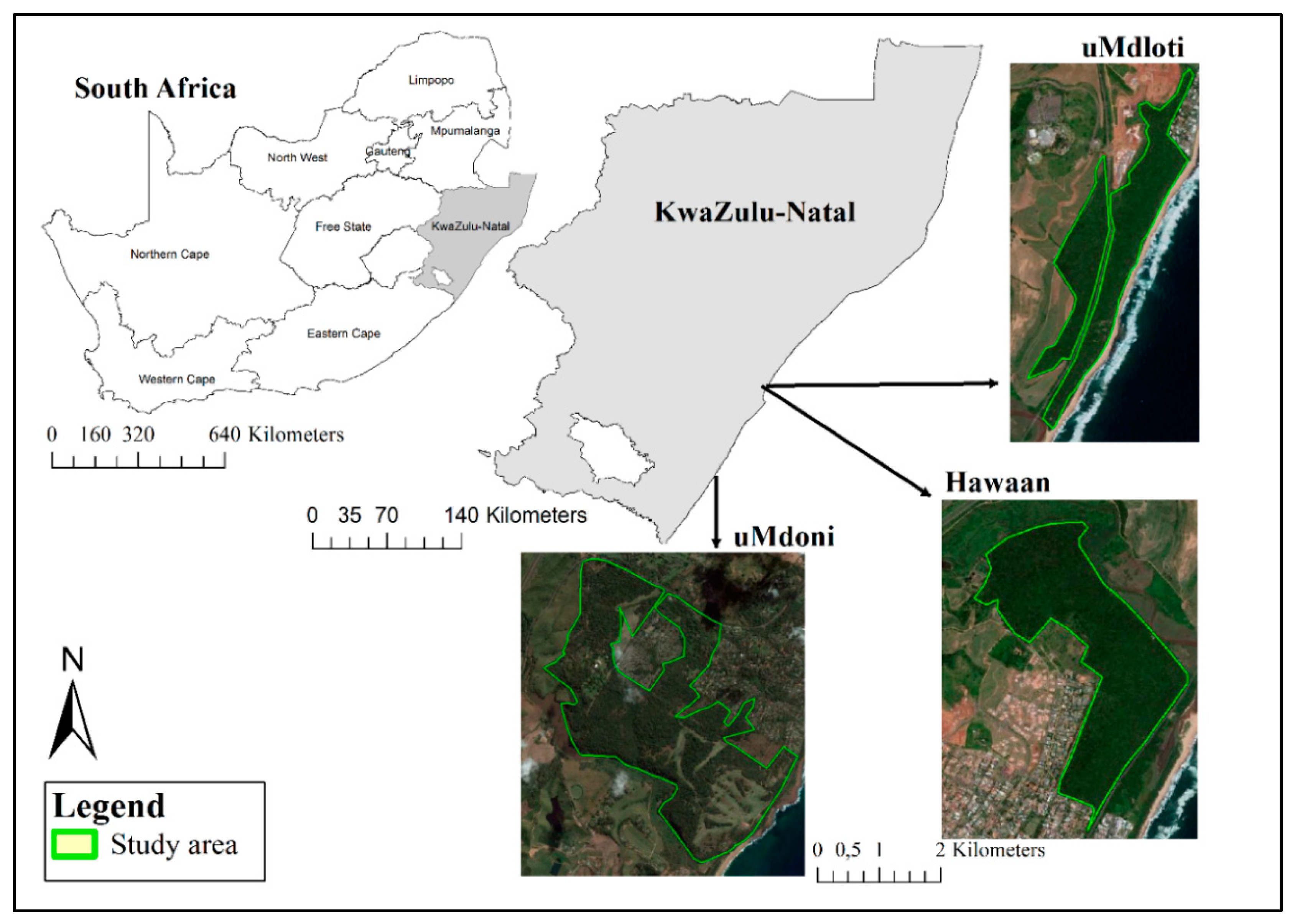
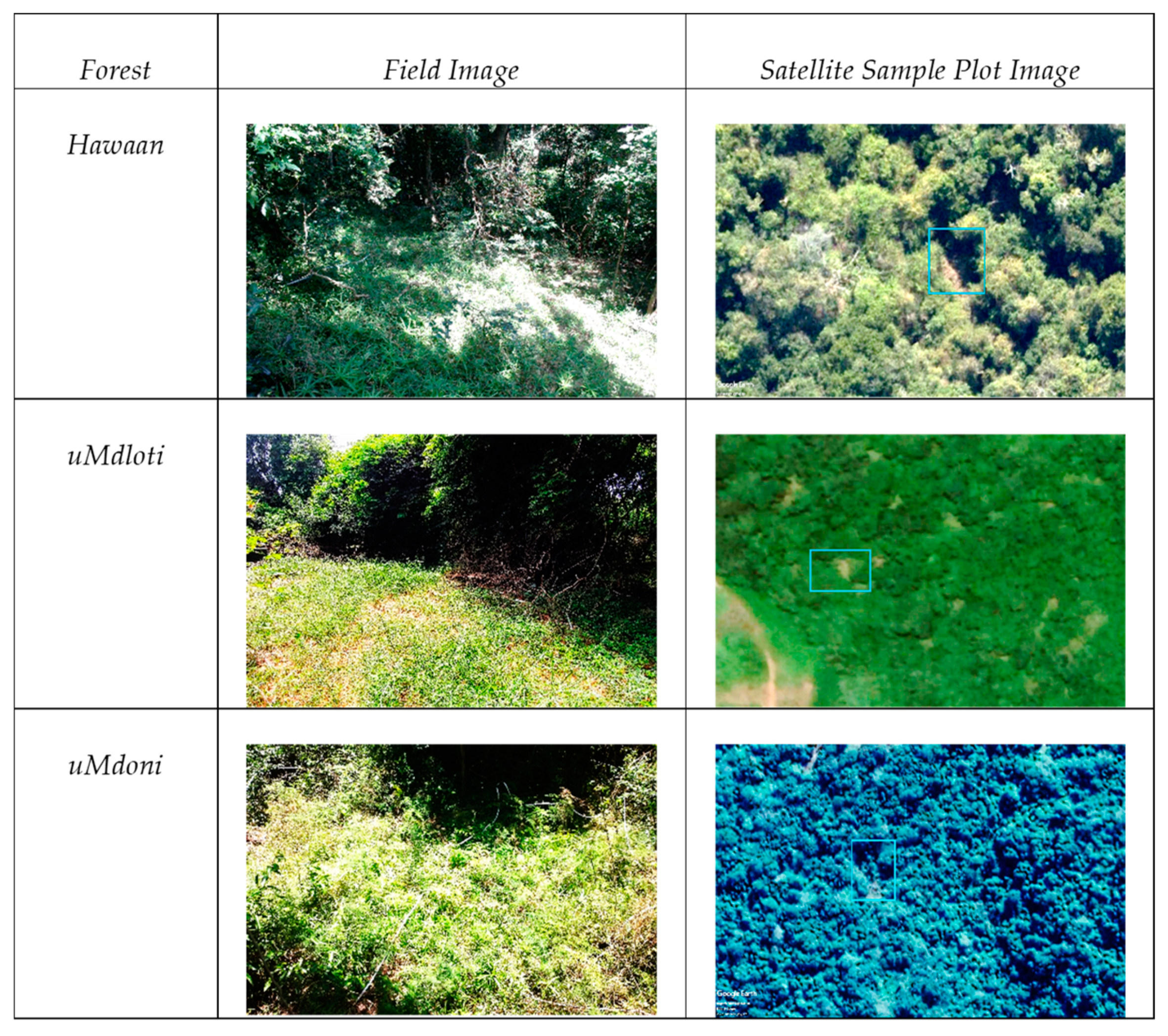
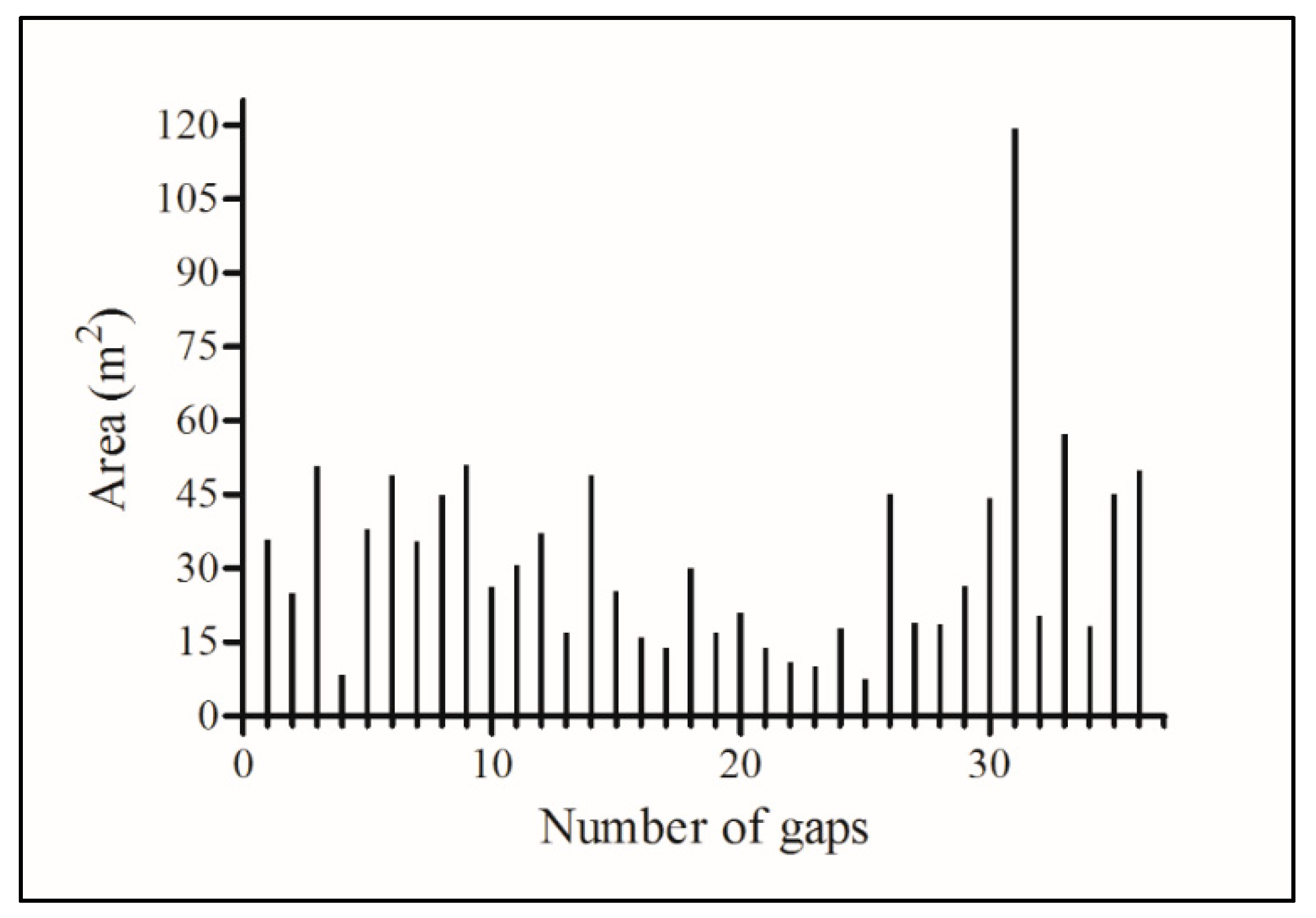
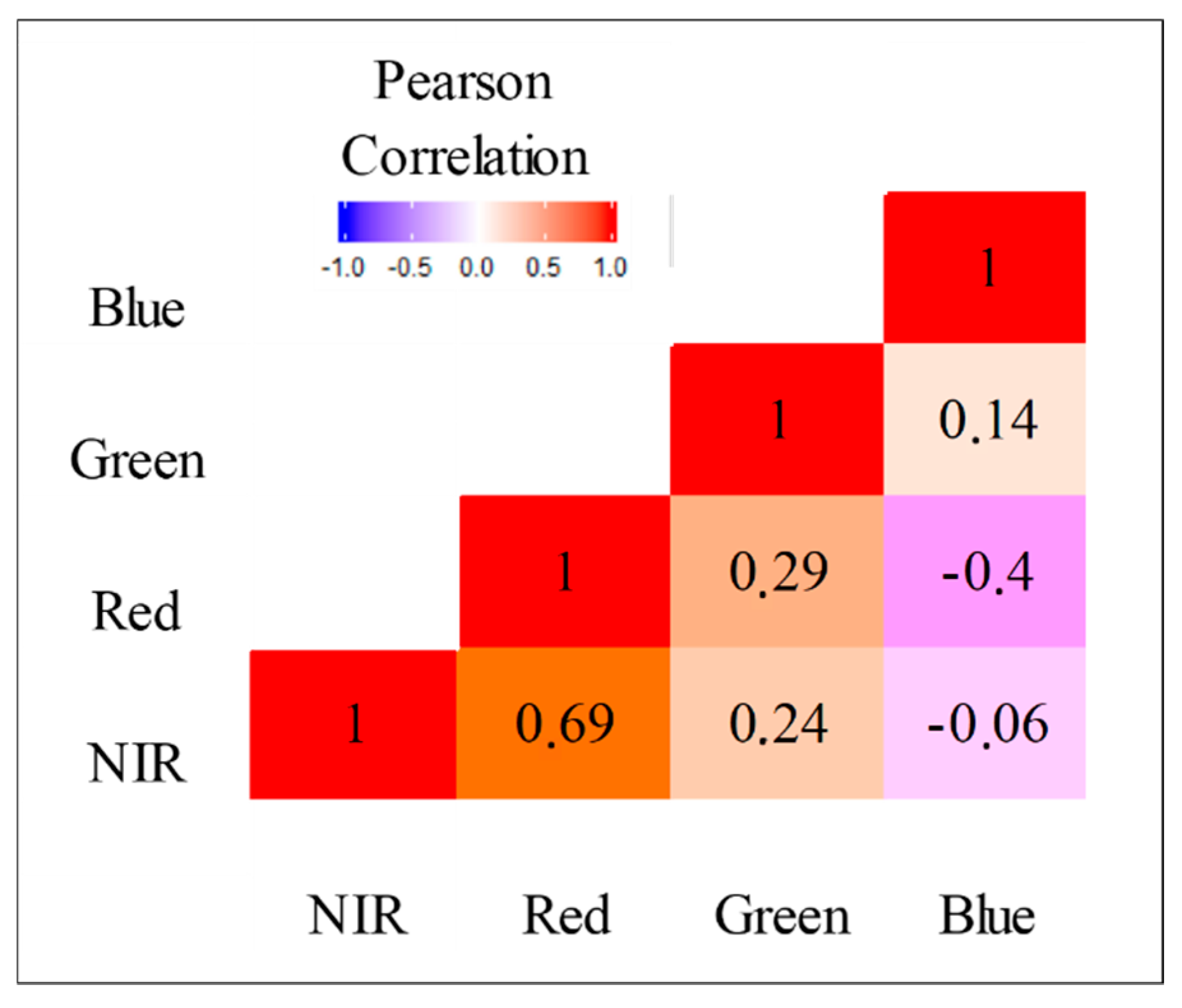
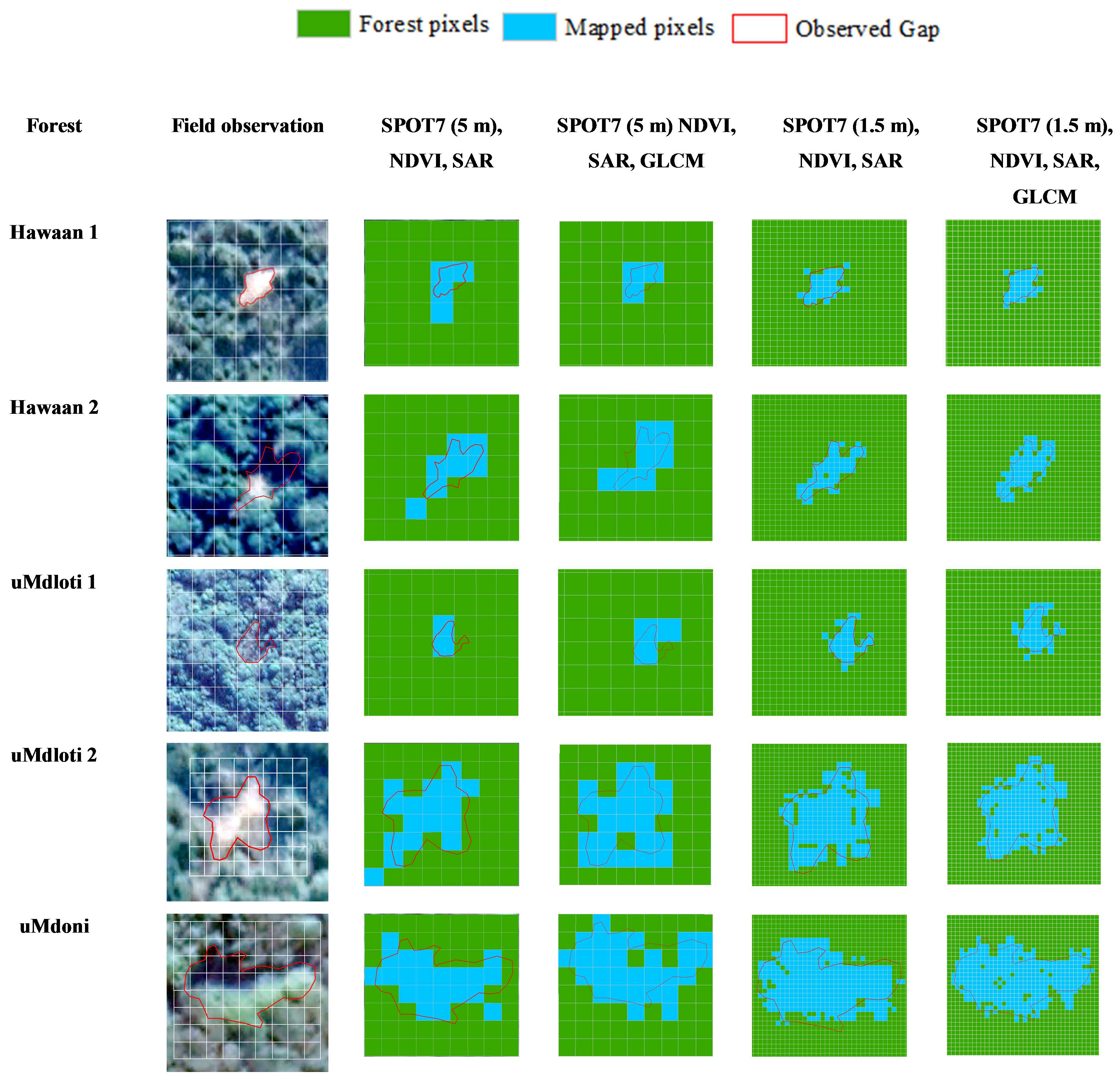
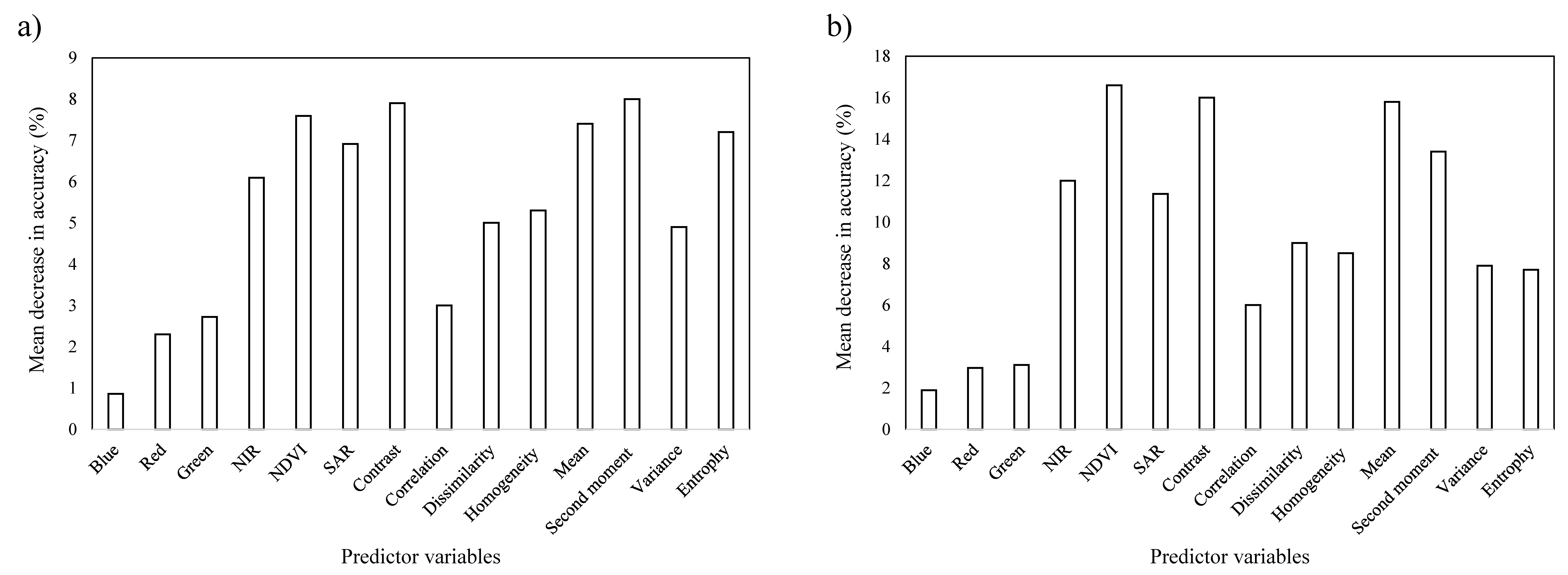
| Forest | Size (km2) | Altitudinal Range (m a.s.l.) | Location | Latitude | Longitude |
|---|---|---|---|---|---|
| Hawaan | 1.26 | 71 | uMhlanga | 29°42′38.30″ S | 31°5′24.20″ E |
| uMdoni | 3.27 | 26 | uMdoni | 30°23′53.23″ S | 30°41′16.77″ E |
| uMdloti | 0.97 | 37 | uMdloti | 29°40′49.64″ S | 31°6′38.73″ E |
| Intact Canopy | Gaps | Row Total | User’s Accuracy (%) | |
|---|---|---|---|---|
| Intact canopy | 120 | 50 | 170 | 70.59 |
| Gaps | 60 | 130 | 190 | 68.42 |
| Column total | 180 | 180 | 360 | |
| Producer’s accuracy (%) | 66.67 | 72.22 |
| Intact Canopy | Gaps | Row Total | User’s Accuracy (%) | |
|---|---|---|---|---|
| Intact canopy | 130 | 30 | 160 | 81.25 |
| Gaps | 50 | 150 | 200 | 75.00 |
| Column total | 180 | 180 | 360 | |
| Producer’s accuracy (%) | 72.22 | 83.33 |
| SPOT7 (5 m), NDVI, SAR | SPOT7 (5 m), NDVI, SAR, GLCM | SPOT7 (1.5 m), NDVI, SAR | SPOT7 (1.5 m), NDVI, SAR, GLCM | |||||
|---|---|---|---|---|---|---|---|---|
| PA | UA | PA | UA | PA | UA | PA | UA | |
| Gap | 72 | 68 | 78 | 74 | 83 | 75 | 89 | 84 |
| Intact canopy | 67 | 71 | 72 | 76 | 72 | 81 | 83 | 88 |
| Std deviation | 3.54 | 2.12 | 4.24 | 1.41 | 7.78 | 4.42 | 4.24 | 2.83 |
| Overall accuracy (%) | 69.44 | 75.00 | 77.78 | 86.11 | ||||
| Std deviation | 3.93 | 5.89 | ||||||
| Kappa coefficient (ϰ) | 0.59 | 0.70 | 0.66 | 0.72 | ||||
© 2018 by the authors. Licensee MDPI, Basel, Switzerland. This article is an open access article distributed under the terms and conditions of the Creative Commons Attribution (CC BY) license (http://creativecommons.org/licenses/by/4.0/).
Share and Cite
Bhugeloo, A.; Peerbhay, K.; Ramdhani, S.; Sershen. Assessing the Trade-Offs of SPOT7 Imagery for Monitoring Natural Forest Canopy Intactness. Forests 2018, 9, 781. https://doi.org/10.3390/f9120781
Bhugeloo A, Peerbhay K, Ramdhani S, Sershen. Assessing the Trade-Offs of SPOT7 Imagery for Monitoring Natural Forest Canopy Intactness. Forests. 2018; 9(12):781. https://doi.org/10.3390/f9120781
Chicago/Turabian StyleBhugeloo, Astika, Kabir Peerbhay, Syd Ramdhani, and Sershen. 2018. "Assessing the Trade-Offs of SPOT7 Imagery for Monitoring Natural Forest Canopy Intactness" Forests 9, no. 12: 781. https://doi.org/10.3390/f9120781
APA StyleBhugeloo, A., Peerbhay, K., Ramdhani, S., & Sershen. (2018). Assessing the Trade-Offs of SPOT7 Imagery for Monitoring Natural Forest Canopy Intactness. Forests, 9(12), 781. https://doi.org/10.3390/f9120781






